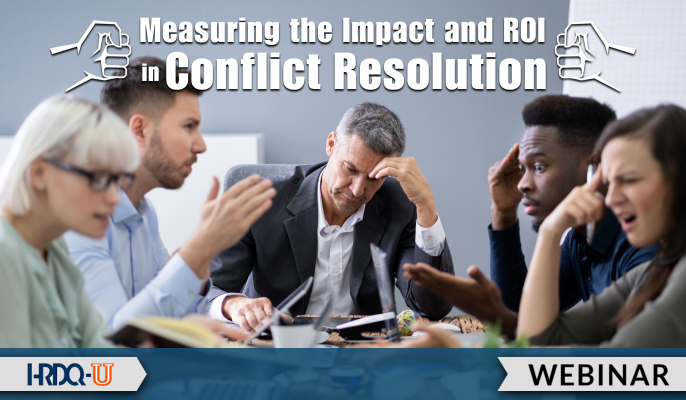- 827 Lincoln Ave. #B-10 West Chester, PA 19380
- support@hrdq.com
- +1-610-279-2002
Quick Links
Menu
Featured Topics
Menu
Total Results
We could not find what you're looking for. Please try again.No Record Found

The pandemic has undoubtedly played a role in the increase of conflict resolution solutions. As we shifted to remote working, experienced technology troubles with virtual learning, navigated new shared workspaces, and redefined many of our roles, we learned that with every conflict comes some form of resolution. Whether resolved by supervisors, an ombudsperson, grievances, or legal action, conflicts can be costly. Conflict resolution programs are aimed at reducing, minimizing, and ultimately trying to avoid conflicts. So how can you prove the investment in conflict resolution programs is worth it?
This session will describe and show how conflict resolution programs are evaluated at five levels of outcome: reaction, learning, application, impact, and ROI. Following the 12-step ROI Methodology®, this session will show you how to align the program to a business measure in the beginning and design for success throughout the program, how to collect data, how to isolate the conflict resolution program’s effects from other influences, how to convert the impact to money, and how to calculate the ROI. Using examples, case studies, and exercises, this session will be practical and relevant.


Jack J. Phillips, Ph.D., chairman of ROI Institute, Inc., is a world-renowned expert on accountability, measurement, and evaluation. He provides consulting services for Fortune 500 companies, nonprofit entities, and government and non-governmental organizations globally. He is the author or editor of more than 100 books, conducts workshops, and presents at conferences worldwide.
Jack has received several awards for his books and work. The American Society for Training and Development gave him its highest honor, Distinguished Contribution to Workplace Learning and Development. The International Society for Performance Improvement presented Jack with its highest award, the Thomas F. Gilbert Award, for his contribution to human performance technology. On three occasions, Meeting News named him one of the 25 Most Powerful People in the Meetings and Events Industry, based on his work on ROI. The Society for Human Resource Management presented him with an award for one of his books and honored a Phillips ROI study with its highest award for creativity. In 2019, Jack, along with his wife Patti P. Phillips, received the Distinguished Contributor Award by the Center for Talent Reporting for their contribution to the measurement and management of human capital. His work has been featured in the Wall Street Journal, BusinessWeek, and Fortune. He has been interviewed by several television programs, including CNN.
Jack regularly consults with clients in manufacturing, service, and government organizations in 70 countries around the world.
Connect with Jack on Facebook, Twitter, and at www.roiinstitute.net. He can also be reached at jack@roiinstitute.net.
Training Tools for Developing Great People Skills
This event is sponsored by HRDQ. For 45 years HRDQ has provided research-based, off-the-shelf soft-skills training resources for classroom, virtual, and online training. From assessments and workshops to experiential hands-on games, HRDQ helps organizations improve performance, increase job satisfaction, and more.
Learn more at HRDQstore.com

Sign up to be notified of upcoming live webinars, in-depth workshops, podcasts, blog posts, promotions and much more. Stay ahead of the curve and subscribe for FREE today!